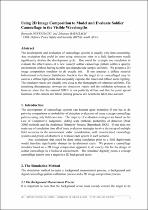 ResearchSpace
ResearchSpace
Using 2D image composition to model and evaluate soldier camouflage in the visible wavelengths
JavaScript is disabled for your browser. Some features of this site may not work without it.
- ResearchSpace
- →
- Research Publications/Outputs
- →
- Conference Publications
- →
- View Item
| dc.contributor.author |
Duvenhage B

|
|
| dc.contributor.author |
Baumbach J

|
|
| dc.date.accessioned | 2011-07-01T07:24:43Z | |
| dc.date.available | 2011-07-01T07:24:43Z | |
| dc.date.issued | 2011-06 | |
| dc.identifier.citation | Duvenhage, B, and Baumbach, J. 2011. Using 2D image composition to model and evaluate soldier camouflage in the visible wavelengths. Midterm Meeting of the International Colour Association (AIC 2011), Zurich, Switzerland, 6-10 June 2011, pp. 4 | en_US |
| dc.identifier.isbn | 978-3-033-02929-3 | |
| dc.identifier.uri | http://www.aic2011.org/downloads/AIC_2011_Book-of-Abstracts_web.pdf | |
| dc.identifier.uri | http://hdl.handle.net/10204/5077 | |
| dc.description | Midterm Meeting of the International Colour Association (AIC 2011), Zurich, Switzerland, 6-10 June 2011 | en_US |
| dc.description.abstract | The development and evaluation of camouflage systems is usually very time-consuming. Any evaluation that could be done using simulation prior to a field deployment would significantly shorten the development cycle. One could for example use simulation to evaluate the effectiveness of a new concept soldier camouflage pattern within a specific environment without having to print and manufacture sample uniforms. We present a 2D image composition simulator to do exactly this. If one assumes a diffuse material bidirectional reflectance distribution function then the target to be camouflaged may be used as a diffuse light probe that adequately captures the direct and diffuse scene lighting. The simulator results are visually very close to the photographs of reference uniforms. The remaining discrepancies between the simulation results and the validation references do however show that the material BRDF is not perfectly diffuse and that the point spread functions of the camera and fabric printing process still need to be taken into account. | en_US |
| dc.language.iso | en | en_US |
| dc.relation.ispartofseries | Workflow;6720 | |
| dc.subject | Camouflage systems | en_US |
| dc.subject | 2D image composition | en_US |
| dc.subject | Soldier camouflage | en_US |
| dc.subject | Fresnel reflection | en_US |
| dc.title | Using 2D image composition to model and evaluate soldier camouflage in the visible wavelengths | en_US |
| dc.type | Conference Presentation | en_US |
| dc.identifier.apacitation | Duvenhage B, & Baumbach J (2011). Using 2D image composition to model and evaluate soldier camouflage in the visible wavelengths. http://hdl.handle.net/10204/5077 | en_ZA |
| dc.identifier.chicagocitation | Duvenhage B, and Baumbach J. "Using 2D image composition to model and evaluate soldier camouflage in the visible wavelengths." (2011): http://hdl.handle.net/10204/5077 | en_ZA |
| dc.identifier.vancouvercitation | Duvenhage B, Baumbach J, Using 2D image composition to model and evaluate soldier camouflage in the visible wavelengths; 2011. http://hdl.handle.net/10204/5077 . | en_ZA |
| dc.identifier.ris | TY - Conference Presentation AU - Duvenhage B AU - Baumbach J AB - The development and evaluation of camouflage systems is usually very time-consuming. Any evaluation that could be done using simulation prior to a field deployment would significantly shorten the development cycle. One could for example use simulation to evaluate the effectiveness of a new concept soldier camouflage pattern within a specific environment without having to print and manufacture sample uniforms. We present a 2D image composition simulator to do exactly this. If one assumes a diffuse material bidirectional reflectance distribution function then the target to be camouflaged may be used as a diffuse light probe that adequately captures the direct and diffuse scene lighting. The simulator results are visually very close to the photographs of reference uniforms. The remaining discrepancies between the simulation results and the validation references do however show that the material BRDF is not perfectly diffuse and that the point spread functions of the camera and fabric printing process still need to be taken into account. DA - 2011-06 DB - ResearchSpace DP - CSIR KW - Camouflage systems KW - 2D image composition KW - Soldier camouflage KW - Fresnel reflection LK - https://researchspace.csir.co.za PY - 2011 SM - 978-3-033-02929-3 T1 - Using 2D image composition to model and evaluate soldier camouflage in the visible wavelengths TI - Using 2D image composition to model and evaluate soldier camouflage in the visible wavelengths UR - http://hdl.handle.net/10204/5077 ER - | en_ZA |





